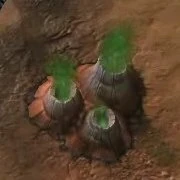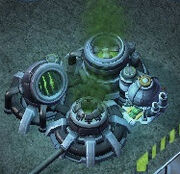
Vespene gas geyser in StarCraft
Vespene gas (or "gas" or "vespene" for short) is one of the two main resources of StarCraft and StarCraft II, the other being minerals.
Overview

Terran-stored vespene

Zerg-stored vespene

Protoss-stored vespene
According to Doran Routhe, a famous United Powers League scientist, planetary systems beyond Sol could contain new resources that could benefit a resource-depleted Earth. Although the terran colonists went beyond their intended destination, Routhe's theories were proven correct, the Koprulu Sector featuring resources not found on Earth, including vespene gas.[1]
Vespene gas is usually green in color,[1] though the color may change through contamination; [2] silver vespene deposits have been observed.[3] It is highly prized by terrans due to its unusually high potential energy rating and as such, is used as a fuel in high-performance engines, energy reactors[1] and simple vehicles in a manner similar to Earth's fossil fuels.[3] Often found in geysers, deposits of vespene can be found on many planets along the galactic rim and in asteroid fields, a number of space platforms having been built to harvest the resource. In addition, vespene can be extracted directly from a planet's crust, albeit with more difficulty.[4] Deposits can be found via geo-survey units, courtesy of the gas's electromagnetic returns.[2] Crystallized vespene can also be found alongside mineral fragments inside asteroids.[5]
Purity of the vespene is highly valued.[6] Hydrogen sulfide is one such impurity, causing the gas mixture to become explosive. Contaminated vespene has a yellowish tinge.[2] Liquid vespene is also usable.[7]
Vespene gas is also used by other races. The zerg have adapted themselves to use raw vespene as a source of nourishment to drive their greatly accelerated metabolisms,[1] raw vespene exposure resulting in enhancement of the ultralisks physical capabilities.[8] In contrast, the protoss use vespene as a catalyst for their psi-driven machines.[1]
Vespene formations slowly regrow over time on planets such as Antiga Prime, contributing greatly to the ability of terrans to survive in the Koprulu Sector.[9] However, while vespene geysers effectively have an unlimited amount of gas within them, after a certain point, the geyser "collapses", with only trace amounts of vespene able to be found.[1] Later reports by Universal News Network stated that vespene was non-renewable, and questioned what would happen when the last geyser was exhausted.[10]
Vespene gas is somewhat flammable if fire of a high enough temperature is applied[3] and explosive with sufficent firepower.[7]
Game Effect
In order to transport and store vespene gas, it must first be sealed in a container, either a tank, box or sac depending on the race. Each race has a type of structure for performing this conversion: the terran refinery, the zerg extractor, and the protoss assimilator. Only one worker unit can be inside the building collecting at any one time, but multiple workers can be queued up to mine from it. Depending on the exact distance from the nearest base, the optimal number of units to be sent to mine a geyser is three or four. Once the fixed amount of gas is expended, the source is said to be depleted, and the workers get a quarter of the normal amount. Generally speaking, the more advanced a unit or structure is, the more vespene gas it requires to produce. Flying units and spellcasters require large amounts of vespene to create.
StarCraft
Typically, a standard mineral patch comes with a lone vespene geyser with 5000 units of gas. Units collect the gas at a rate of 8 units per trip until the geyser is depleted. When a geyser is depleted, the workers will continue to mine but will only produce 2 units of gas per trip.
StarCraft II

Vespene gas geyser in StarCraft II
Compared to the first game, the harvesting of vespene gas is radically different. A standard geyser only has 2500 units of gas, but each mineral patch comes with two geysers. Gas is mined in units of four rather than eight, and the cost of gas-extracting buildings is decreased. Thus, while overall collection of gas is equal to the original game, two workers collectively mining 8 units a second, gas is a more costly investment due to the need for twice as many workers and two gas-extracting buildings instead of one. A depleted geyser can no longer continue to be mined once depleted: the building acquires a reddish tint and the workers harvesting from it cease their work until given new orders.
As with the original, the appearance of vespene geysers in StarCraft II changes in accordance with their tileset.
Vespene resource pallets may be found in campaigns.
Wings of Liberty
In the StarCraft II: Wings of Liberty campaign, vespene harvesting benefits from two upgrades. At 10 protoss research points, the player has the option to increase harvest rates by 25%, resulting in 5 gas being mined per SCV trip. At 15 points, refineries become automated and no longer need SCVs to mine, automatically producing vespene for the player every few seconds. Automated refineries also benefit from the 25% bonus production rate.[11]
Increases the rate SCVs and Automated Refinery harvest vespene gas from refineries by 25% (to 5). Combining terran and protoss filtering technologies allows our refineries and automated refineries to reclaim a higher amount of vespene gas in its purest form.[12]
|
Automated Refinery Refineries do not need SCVs to operate.[12] We have adapted protoss warp technology to transport gas canisters straight from the refinery to the command center, eliminating the need for SCVs to carry them back. Why the protoss have never thought to transport vespene in this fashion is a mystery. Perhaps they lack terran creativity and pragmatism, or possibly their primitive superstitions forbid the practice.
|
Heart of the Swarm
In the StarCraft II: Heart of the Swarm campaign, the zerg have also gain and receive the same vespene harvesting benefits from two upgrades which is similar to the terran campaign mechanics when Sarah Kerrigan reach a certain level with the Supreme mission completed. At level 10, the player has the option of selecting the automated extractor upgrade which no longer need Drones to mine, automatically producing vespene for the player every few seconds. At level 35, the player has the option of selecting the vespene efficiency upgrade which increase harvest rates by 25%, resulting in 5 gas being mined per Drone trip. Automated extractors also benefit from the 25% bonus production rate.
- Automated Extractors: Extractors automatically extract vespene gas without drones. Passive ability.
- Vespene Efficiency: Vespene gas harvesting efficiency increased by 25%. Passive ability.
Legacy of the Void
In Legacy of the Void, gas comes to a total of 2000 per geyser.[13]
In the game's campaign, once the Spear of Adun collects enough solarite, the protoss can collect gas without using probes.
Co-op Missions
In Co-Op missions Vorazun and Nova can harvest vespene without workers once they reach a high level while Swann can call in harvesting drones on refineries to get more.
Calls down an automated harvester that gathers extra vespene for you and your ally from any friendly vespene gathering structure.
| Usage | ||
|---|---|---|
|
| Campaign Acquisition | ||
|---|---|---|
|
The Spear of Adun harvests vespene gas from orbit without the need for Probes.
Passive ability.
| Campaign Acquisition | ||
|---|---|---|
|
Development
The following section contains information from a previous version of StarCraft II which is no longer valid.
|
The process for building alternate art for vespene geysers in StarCraft II was limited by time, which led to a limit of the number of types being present at the game's release. Both natural and artificial geysers had to have the same rough form and their openings in the exact same locations, since terran and zerg gas harvesting buildings cap the holes during their construction animations.[14]
In Legacy of the Void, Blizzard planned to reduce the amount of gas produced by a geyser from 2500 to 1700 in order to encourage more expansions.[15]
- Rich gas

A rich vespene geyser on the map Atlantis Spaceship.
Rich vespene has a standard size of 2500 units and may be collected at a rate of 6 per trip. It may be found in the StarCraft II Map Editor. Rich vespene geysers are distinguished from normal geysers by the small storage tank-looking object on the side.[16]
Rich vespene geysers were included in the IGN Pro League (IPL) 4 map "Atlantis Spaceship."
- Restore Gas
In 2008, a worker would collect 6 vespene gas per trip and the geyser had an initial supply of 1000 units of vespene gas, once depleted the amount harvested per trip was reduced down to 2. Vespene collectors had an ability to "Restore Gas" in which the player would pay 100 minerals and the collector would temporarily shut down for 45 seconds. But once the shut down period was finished, 400 vespene gas would become available to be harvested at 6 vespene gas per trip until this supply was depleted again.[17]
References
|
